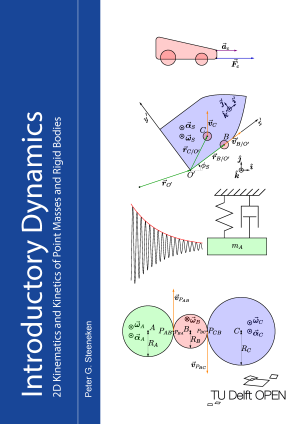Introductory Dynamics: 2D Kinematics and Kinetics of Point Masses and Rigid Bodies, Edition 1.1
Synopsis
Motion is all around us, the universe is full of moving matter and this motion is surprisingly predictable. The field of science and engineering that studies time-dependent motion in the presence of forces is called Dynamics. In this book we will introduce the core concepts in dynamics and provide a comprehensive toolset to predict and analyse planar 2D motion of point masses and rigid bodies. The material includes kinematic analysis, Newton’s laws, Euler’s laws, the equations of motion, work, energy, impulse and momentum. Vector-based methods are discussed for systematically solving essentially any problem in 2D dynamics. The book provides a bachelor level introduction for any science and engineering student that can serve as a basis for more advanced courses in dynamics.
Downloads
References
Bureau International des Poids et Mesures, "Le Système international d'unités / The International System of Units," SI Brochure, 8th edition,2006, updated in 2014. [Online]. Available:https://www.bipm.org/en/publications/si-brochure/
Commission C2 - SUNAMCO, Symbols, units, nomenclature andfundamental constants in physics (The Red Book). International Union of Pure and Applied Physics (IUPAP), 1987 revision (2010 reprint). [Online].Available:https://archive2.iupap.org/wp-content/uploads/2014/05/A4.pdf
L. Euler, "D ́ecouverte d'un nouveau principe de mécanique,"The EulerArchive, pp. E-177, 1752, uRL: http://eulerarchive.maa.org.
Institute of Electrical and Electronics Engineers (IEEE), IEEEConference Template (Overleaf). IEEE, accessed July 28, 2020. [Online].Available:https://www.overleaf.com/latex/templates/ieee-conference-template/grfzhhncsfqn
International Organization for Standardization (ISO),ISO80000-1:2009Quantities and Units - Part 1: General. ISO, Nov. 2009, no. 1. [Online].Available:https://www.iso.org/obp/ui/#iso:std:iso:80000:-1:ed-1:v1:en
Isaac Newton,The Principia, mathematical principles of natural philosophy.Univ of California Press, 1999.
I. Newton, The Mathematical Principles of Natural Philisophy. Benjamin Motte, 1729, vol. 1, translated from Latin to English by Andrew Motte.
Physical Review Journals,Physical Review Style and Notation Guide. American Physical Society, 2012,https://cdn.journals.aps.org/files/styleguide-pr.pdfandhttps://journals.aps.org/authors/axis-labels-and-scales-on-graphs-h18.
H. Vallery and A. L. Schwab, Advanced Dynamics. Stichting Newton-Euler,2020.

Published
Versions
- 2025-02-06 (2)
- 2024-01-09 (1)



